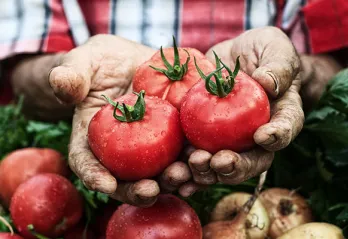Gardening Tip: Tomatoes and Cover Crops

The pride of gardeners everywhere: the vine-ripened, garden fresh tomato is simply unsurpassable. As gardeners, we are able to grow incredible varieties that are not available in the supermarket. This is because tomatoes grown for grocery stores typically travel thousands of miles by truck before they reach the store shelf. The tomatoes are picked green and firm so they aren’t damaged in travel. Upon arrival, they are exposed to ethylene gas, a ripening agent, which turns them red. Unfortunately, it does very little to improve flavor.
This is why the tomato you grow in your garden will always taste better than any tomato you can buy in a store.*
Here are tips for your tomatoes:
1. It is important to handle tomatoes very carefully to prevent bruising. Do not drop them into a bucket or stack them more than two deep. Be careful that the stems of one tomato do not puncture other fruits.
2. Tomatoes hate the cold. Never, under any circumstances, should you put a tomato in the refrigerator. The flavor and texture are compromised at temperatures below 50 degrees Fahrenheit. Store tomatoes on the counter. If you have too many, give them away — you will soon have more.
3. Tomatoes ripen from the blossom end first: Store tomatoes shoulders down on your counter as you allow them to continue ripening. The shoulders will always be more firm than the blossom end. Doing this will prevent a tomato from turning into a puddle in your kitchen.
*Farmer’s markets can be an exception to this. Local growers are also able to harvest fruit at the peak of flavor and maturity since they are transporting their produce across town rather than across the country.
Although, you are likely in the peak of your harvest, now is the time to start thinking about the winter. If you are able to establish crops now while there is still sufficient light and warmth, you can protect and harvest them through the winter, even though they grow only very slowly.
August is also a great time to establish a cover crop, which can protect and feed your soil throughout the winter. I like to use a mix of winter rye, hairy vetch and field peas. If you garden in a place where you don’t control the availability of water, you must think about establishing cover crops while you still have the ability to irrigate them.
Our gardening tip is courtesy of Growing Gardens.
